sensor CHEVROLET CITY EXPRESS 2018 Owner's Manual
[x] Cancel search | Manufacturer: CHEVROLET, Model Year: 2018, Model line: CITY EXPRESS, Model: CHEVROLET CITY EXPRESS 2018Pages: 287, PDF Size: 4.19 MB
Page 19 of 287
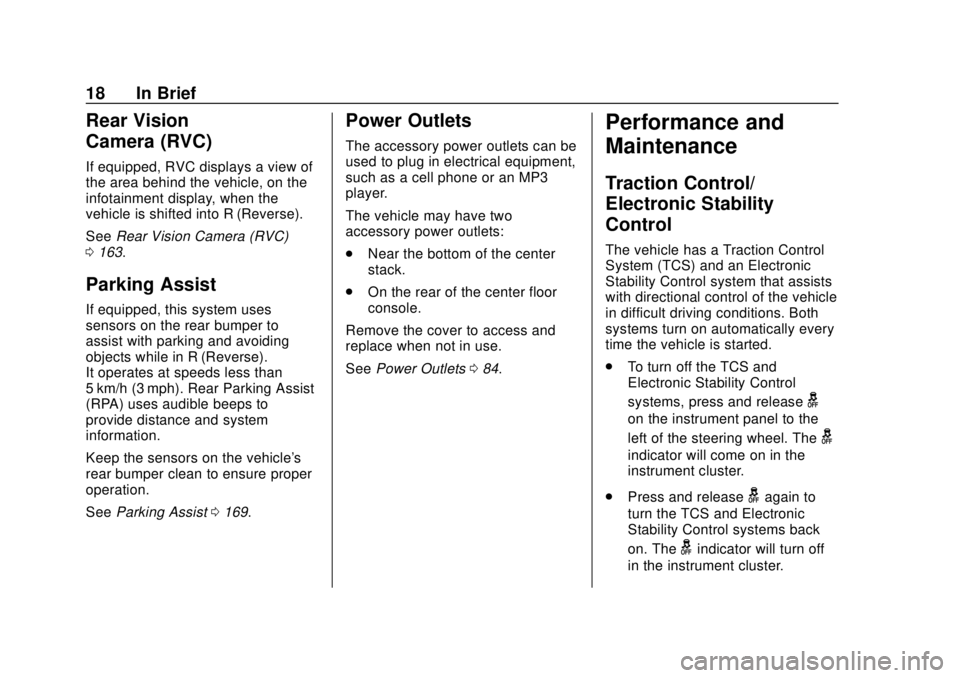
Chevrolet City Express Owner Manual (GMNA-Localizing-U.S./Canada-
11683523) - 2018 - CRC - 7/10/17
18 In Brief
Rear Vision
Camera (RVC)
If equipped, RVC displays a view of
the area behind the vehicle, on the
infotainment display, when the
vehicle is shifted into R (Reverse).
SeeRear Vision Camera (RVC)
0 163.
Parking Assist
If equipped, this system uses
sensors on the rear bumper to
assist with parking and avoiding
objects while in R (Reverse).
It operates at speeds less than
5 km/h (3 mph). Rear Parking Assist
(RPA) uses audible beeps to
provide distance and system
information.
Keep the sensors on the vehicle's
rear bumper clean to ensure proper
operation.
See Parking Assist 0169.
Power Outlets
The accessory power outlets can be
used to plug in electrical equipment,
such as a cell phone or an MP3
player.
The vehicle may have two
accessory power outlets:
.
Near the bottom of the center
stack.
. On the rear of the center floor
console.
Remove the cover to access and
replace when not in use.
See Power Outlets 084.
Performance and
Maintenance
Traction Control/
Electronic Stability
Control
The vehicle has a Traction Control
System (TCS) and an Electronic
Stability Control system that assists
with directional control of the vehicle
in difficult driving conditions. Both
systems turn on automatically every
time the vehicle is started.
.
To turn off the TCS and
Electronic Stability Control
systems, press and release
g
on the instrument panel to the
left of the steering wheel. The
g
indicator will come on in the
instrument cluster.
. Press and release
gagain to
turn the TCS and Electronic
Stability Control systems back
on. The
gindicator will turn off
in the instrument cluster.
Page 53 of 287
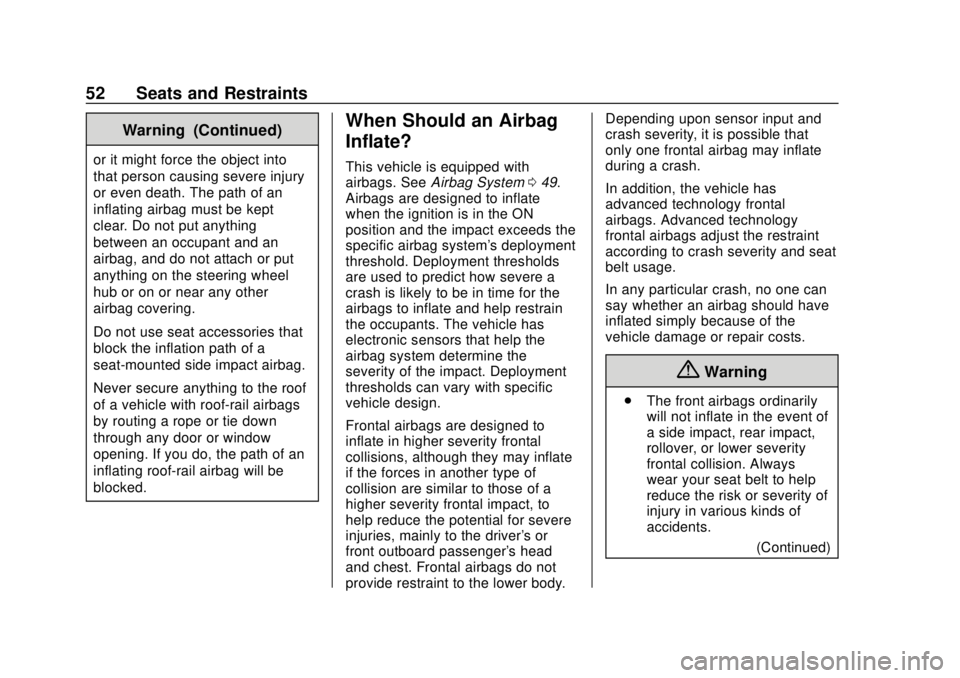
Chevrolet City Express Owner Manual (GMNA-Localizing-U.S./Canada-
11683523) - 2018 - CRC - 7/10/17
52 Seats and Restraints
Warning (Continued)
or it might force the object into
that person causing severe injury
or even death. The path of an
inflating airbag must be kept
clear. Do not put anything
between an occupant and an
airbag, and do not attach or put
anything on the steering wheel
hub or on or near any other
airbag covering.
Do not use seat accessories that
block the inflation path of a
seat-mounted side impact airbag.
Never secure anything to the roof
of a vehicle with roof-rail airbags
by routing a rope or tie‐down
through any door or window
opening. If you do, the path of an
inflating roof-rail airbag will be
blocked.
When Should an Airbag
Inflate?
This vehicle is equipped with
airbags. SeeAirbag System 049.
Airbags are designed to inflate
when the ignition is in the ON
position and the impact exceeds the
specific airbag system's deployment
threshold. Deployment thresholds
are used to predict how severe a
crash is likely to be in time for the
airbags to inflate and help restrain
the occupants. The vehicle has
electronic sensors that help the
airbag system determine the
severity of the impact. Deployment
thresholds can vary with specific
vehicle design.
Frontal airbags are designed to
inflate in higher severity frontal
collisions, although they may inflate
if the forces in another type of
collision are similar to those of a
higher severity frontal impact, to
help reduce the potential for severe
injuries, mainly to the driver's or
front outboard passenger's head
and chest. Frontal airbags do not
provide restraint to the lower body. Depending upon sensor input and
crash severity, it is possible that
only one frontal airbag may inflate
during a crash.
In addition, the vehicle has
advanced technology frontal
airbags. Advanced technology
frontal airbags adjust the restraint
according to crash severity and seat
belt usage.
In any particular crash, no one can
say whether an airbag should have
inflated simply because of the
vehicle damage or repair costs.
{Warning
.
The front airbags ordinarily
will not inflate in the event of
a side impact, rear impact,
rollover, or lower severity
frontal collision. Always
wear your seat belt to help
reduce the risk or severity of
injury in various kinds of
accidents.
(Continued)
Page 54 of 287
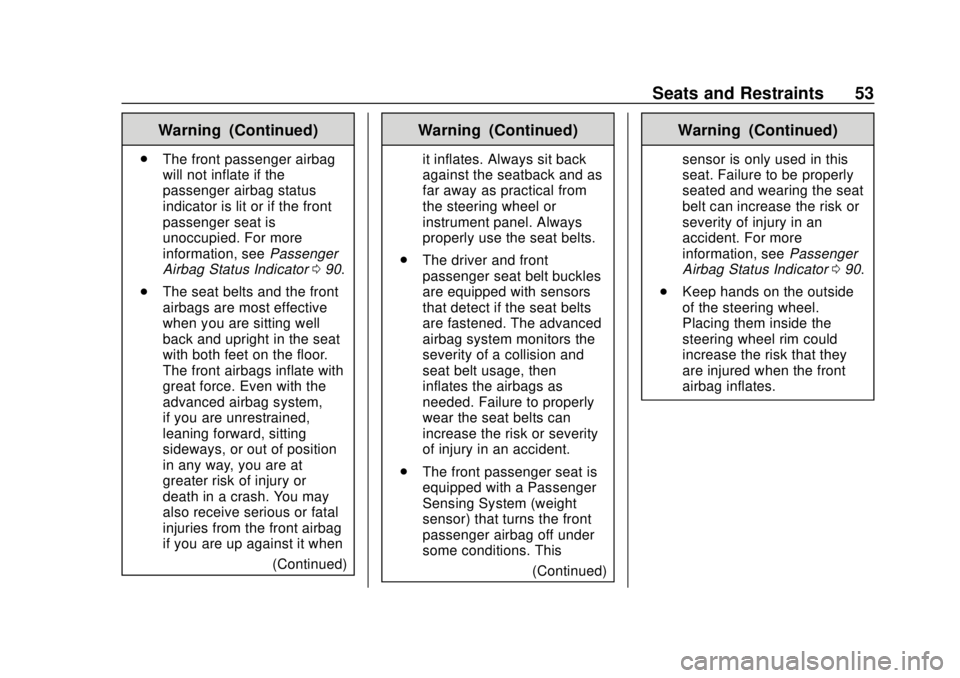
Chevrolet City Express Owner Manual (GMNA-Localizing-U.S./Canada-
11683523) - 2018 - CRC - 7/10/17
Seats and Restraints 53
Warning (Continued)
.The front passenger airbag
will not inflate if the
passenger airbag status
indicator is lit or if the front
passenger seat is
unoccupied. For more
information, see Passenger
Airbag Status Indicator 090.
. The seat belts and the front
airbags are most effective
when you are sitting well
back and upright in the seat
with both feet on the floor.
The front airbags inflate with
great force. Even with the
advanced airbag system,
if you are unrestrained,
leaning forward, sitting
sideways, or out of position
in any way, you are at
greater risk of injury or
death in a crash. You may
also receive serious or fatal
injuries from the front airbag
if you are up against it when
(Continued)
Warning (Continued)
it inflates. Always sit back
against the seatback and as
far away as practical from
the steering wheel or
instrument panel. Always
properly use the seat belts.
. The driver and front
passenger seat belt buckles
are equipped with sensors
that detect if the seat belts
are fastened. The advanced
airbag system monitors the
severity of a collision and
seat belt usage, then
inflates the airbags as
needed. Failure to properly
wear the seat belts can
increase the risk or severity
of injury in an accident.
. The front passenger seat is
equipped with a Passenger
Sensing System (weight
sensor) that turns the front
passenger airbag off under
some conditions. This
(Continued)
Warning (Continued)
sensor is only used in this
seat. Failure to be properly
seated and wearing the seat
belt can increase the risk or
severity of injury in an
accident. For more
information, seePassenger
Airbag Status Indicator 090.
. Keep hands on the outside
of the steering wheel.
Placing them inside the
steering wheel rim could
increase the risk that they
are injured when the front
airbag inflates.
Page 58 of 287
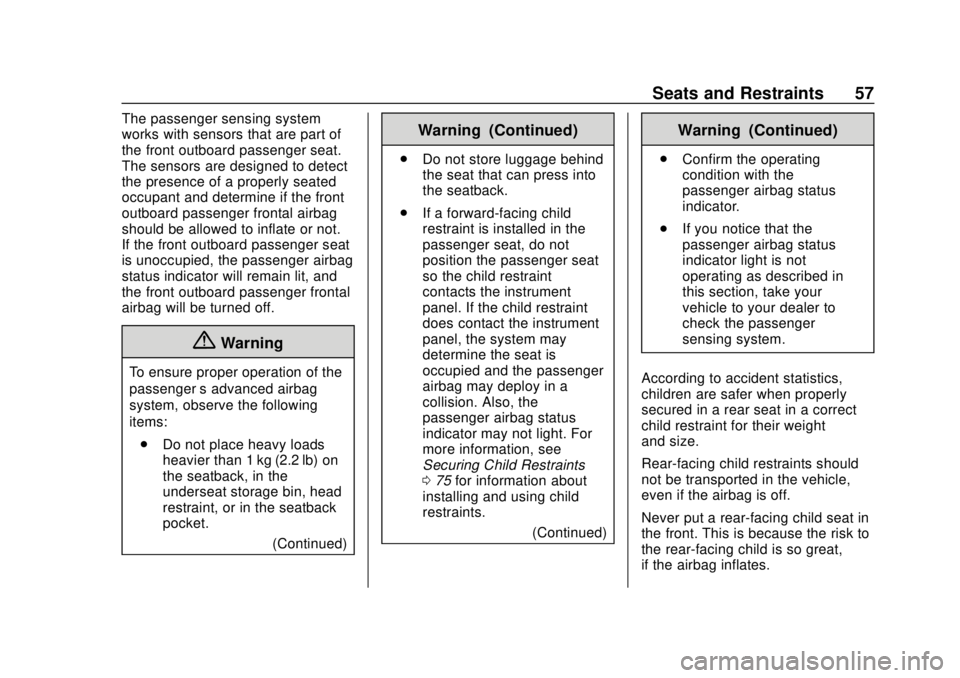
Chevrolet City Express Owner Manual (GMNA-Localizing-U.S./Canada-
11683523) - 2018 - CRC - 7/10/17
Seats and Restraints 57
The passenger sensing system
works with sensors that are part of
the front outboard passenger seat.
The sensors are designed to detect
the presence of a properly seated
occupant and determine if the front
outboard passenger frontal airbag
should be allowed to inflate or not.
If the front outboard passenger seat
is unoccupied, the passenger airbag
status indicator will remain lit, and
the front outboard passenger frontal
airbag will be turned off.
{Warning
To ensure proper operation of the
passenger’s advanced airbag
system, observe the following
items:
. Do not place heavy loads
heavier than 1 kg (2.2 lb) on
the seatback, in the
underseat storage bin, head
restraint, or in the seatback
pocket.
(Continued)
Warning (Continued)
.Do not store luggage behind
the seat that can press into
the seatback.
. If a forward-facing child
restraint is installed in the
passenger seat, do not
position the passenger seat
so the child restraint
contacts the instrument
panel. If the child restraint
does contact the instrument
panel, the system may
determine the seat is
occupied and the passenger
airbag may deploy in a
collision. Also, the
passenger airbag status
indicator may not light. For
more information, see
Securing Child Restraints
075 for information about
installing and using child
restraints.
(Continued)
Warning (Continued)
.Confirm the operating
condition with the
passenger airbag status
indicator.
. If you notice that the
passenger airbag status
indicator light is not
operating as described in
this section, take your
vehicle to your dealer to
check the passenger
sensing system.
According to accident statistics,
children are safer when properly
secured in a rear seat in a correct
child restraint for their weight
and size.
Rear-facing child restraints should
not be transported in the vehicle,
even if the airbag is off.
Never put a rear-facing child seat in
the front. This is because the risk to
the rear-facing child is so great,
if the airbag inflates.
Page 62 of 287
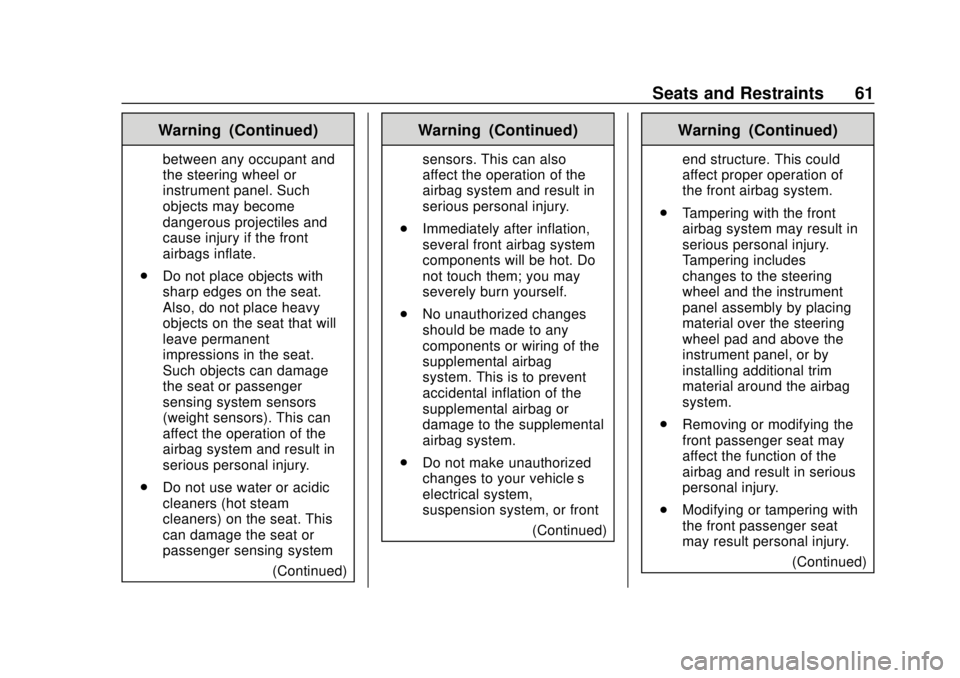
Chevrolet City Express Owner Manual (GMNA-Localizing-U.S./Canada-
11683523) - 2018 - CRC - 7/10/17
Seats and Restraints 61
Warning (Continued)
between any occupant and
the steering wheel or
instrument panel. Such
objects may become
dangerous projectiles and
cause injury if the front
airbags inflate.
. Do not place objects with
sharp edges on the seat.
Also, do not place heavy
objects on the seat that will
leave permanent
impressions in the seat.
Such objects can damage
the seat or passenger
sensing system sensors
(weight sensors). This can
affect the operation of the
airbag system and result in
serious personal injury.
. Do not use water or acidic
cleaners (hot steam
cleaners) on the seat. This
can damage the seat or
passenger sensing system
(Continued)
Warning (Continued)
sensors. This can also
affect the operation of the
airbag system and result in
serious personal injury.
. Immediately after inflation,
several front airbag system
components will be hot. Do
not touch them; you may
severely burn yourself.
. No unauthorized changes
should be made to any
components or wiring of the
supplemental airbag
system. This is to prevent
accidental inflation of the
supplemental airbag or
damage to the supplemental
airbag system.
. Do not make unauthorized
changes to your vehicle’s
electrical system,
suspension system, or front
(Continued)
Warning (Continued)
end structure. This could
affect proper operation of
the front airbag system.
. Tampering with the front
airbag system may result in
serious personal injury.
Tampering includes
changes to the steering
wheel and the instrument
panel assembly by placing
material over the steering
wheel pad and above the
instrument panel, or by
installing additional trim
material around the airbag
system.
. Removing or modifying the
front passenger seat may
affect the function of the
airbag and result in serious
personal injury.
. Modifying or tampering with
the front passenger seat
may result personal injury.
(Continued)
Page 63 of 287
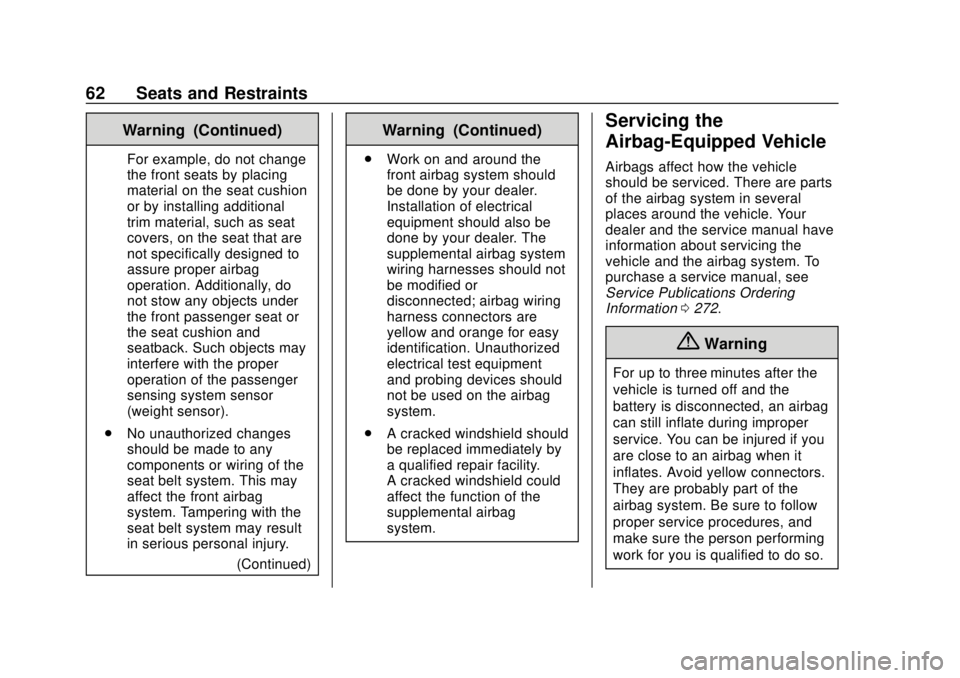
Chevrolet City Express Owner Manual (GMNA-Localizing-U.S./Canada-
11683523) - 2018 - CRC - 7/10/17
62 Seats and Restraints
Warning (Continued)
For example, do not change
the front seats by placing
material on the seat cushion
or by installing additional
trim material, such as seat
covers, on the seat that are
not specifically designed to
assure proper airbag
operation. Additionally, do
not stow any objects under
the front passenger seat or
the seat cushion and
seatback. Such objects may
interfere with the proper
operation of the passenger
sensing system sensor
(weight sensor).
. No unauthorized changes
should be made to any
components or wiring of the
seat belt system. This may
affect the front airbag
system. Tampering with the
seat belt system may result
in serious personal injury.
(Continued)
Warning (Continued)
.Work on and around the
front airbag system should
be done by your dealer.
Installation of electrical
equipment should also be
done by your dealer. The
supplemental airbag system
wiring harnesses should not
be modified or
disconnected; airbag wiring
harness connectors are
yellow and orange for easy
identification. Unauthorized
electrical test equipment
and probing devices should
not be used on the airbag
system.
. A cracked windshield should
be replaced immediately by
a qualified repair facility.
A cracked windshield could
affect the function of the
supplemental airbag
system.
Servicing the
Airbag-Equipped Vehicle
Airbags affect how the vehicle
should be serviced. There are parts
of the airbag system in several
places around the vehicle. Your
dealer and the service manual have
information about servicing the
vehicle and the airbag system. To
purchase a service manual, see
Service Publications Ordering
Information 0272.
{Warning
For up to three minutes after the
vehicle is turned off and the
battery is disconnected, an airbag
can still inflate during improper
service. You can be injured if you
are close to an airbag when it
inflates. Avoid yellow connectors.
They are probably part of the
airbag system. Be sure to follow
proper service procedures, and
make sure the person performing
work for you is qualified to do so.
Page 64 of 287
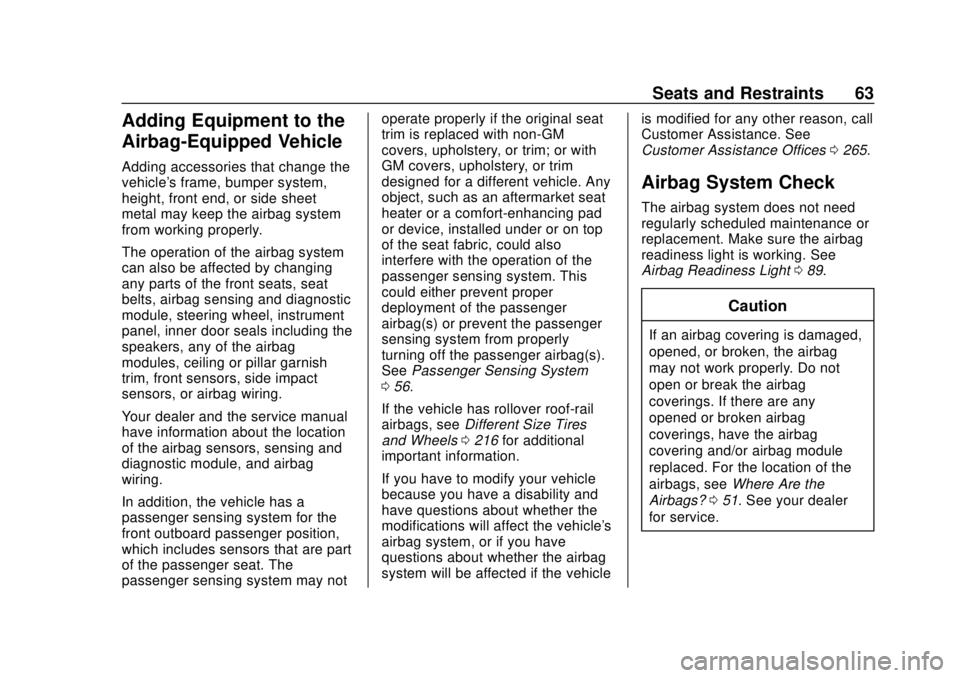
Chevrolet City Express Owner Manual (GMNA-Localizing-U.S./Canada-
11683523) - 2018 - CRC - 7/10/17
Seats and Restraints 63
Adding Equipment to the
Airbag-Equipped Vehicle
Adding accessories that change the
vehicle's frame, bumper system,
height, front end, or side sheet
metal may keep the airbag system
from working properly.
The operation of the airbag system
can also be affected by changing
any parts of the front seats, seat
belts, airbag sensing and diagnostic
module, steering wheel, instrument
panel, inner door seals including the
speakers, any of the airbag
modules, ceiling or pillar garnish
trim, front sensors, side impact
sensors, or airbag wiring.
Your dealer and the service manual
have information about the location
of the airbag sensors, sensing and
diagnostic module, and airbag
wiring.
In addition, the vehicle has a
passenger sensing system for the
front outboard passenger position,
which includes sensors that are part
of the passenger seat. The
passenger sensing system may notoperate properly if the original seat
trim is replaced with non-GM
covers, upholstery, or trim; or with
GM covers, upholstery, or trim
designed for a different vehicle. Any
object, such as an aftermarket seat
heater or a comfort-enhancing pad
or device, installed under or on top
of the seat fabric, could also
interfere with the operation of the
passenger sensing system. This
could either prevent proper
deployment of the passenger
airbag(s) or prevent the passenger
sensing system from properly
turning off the passenger airbag(s).
See
Passenger Sensing System
0 56.
If the vehicle has rollover roof-rail
airbags, see Different Size Tires
and Wheels 0216 for additional
important information.
If you have to modify your vehicle
because you have a disability and
have questions about whether the
modifications will affect the vehicle's
airbag system, or if you have
questions about whether the airbag
system will be affected if the vehicle is modified for any other reason, call
Customer Assistance. See
Customer Assistance Offices
0265.
Airbag System Check
The airbag system does not need
regularly scheduled maintenance or
replacement. Make sure the airbag
readiness light is working. See
Airbag Readiness Light 089.
Caution
If an airbag covering is damaged,
opened, or broken, the airbag
may not work properly. Do not
open or break the airbag
coverings. If there are any
opened or broken airbag
coverings, have the airbag
covering and/or airbag module
replaced. For the location of the
airbags, see Where Are the
Airbags? 051. See your dealer
for service.
Page 90 of 287
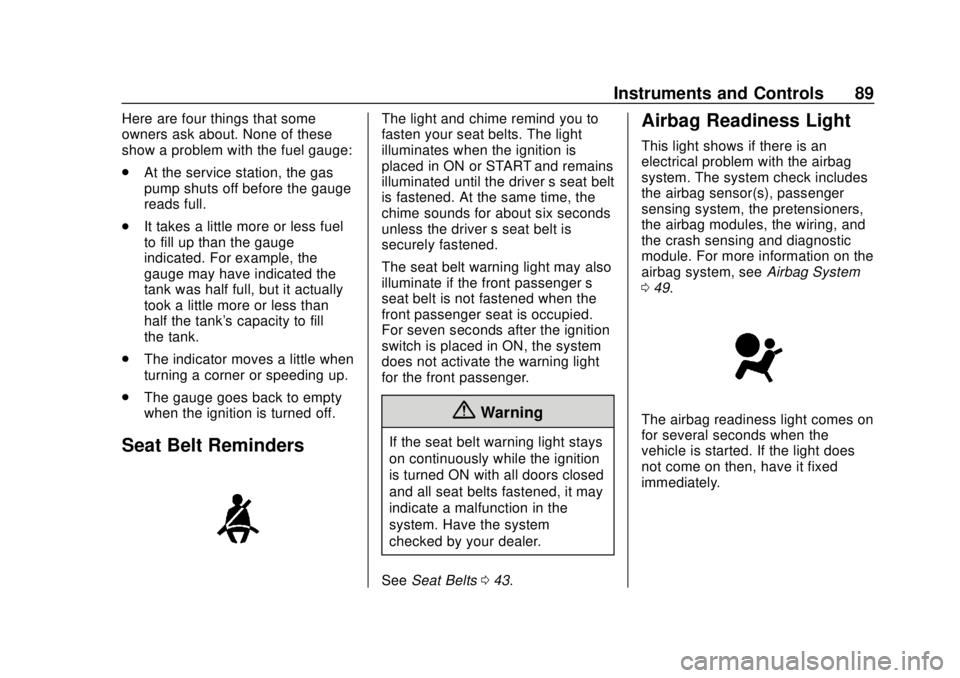
Chevrolet City Express Owner Manual (GMNA-Localizing-U.S./Canada-
11683523) - 2018 - CRC - 7/10/17
Instruments and Controls 89
Here are four things that some
owners ask about. None of these
show a problem with the fuel gauge:
.At the service station, the gas
pump shuts off before the gauge
reads full.
. It takes a little more or less fuel
to fill up than the gauge
indicated. For example, the
gauge may have indicated the
tank was half full, but it actually
took a little more or less than
half the tank's capacity to fill
the tank.
. The indicator moves a little when
turning a corner or speeding up.
. The gauge goes back to empty
when the ignition is turned off.
Seat Belt Reminders
The light and chime remind you to
fasten your seat belts. The light
illuminates when the ignition is
placed in ON or START and remains
illuminated until the driver ’s seat belt
is fastened. At the same time, the
chime sounds for about six seconds
unless the driver ’s seat belt is
securely fastened.
The seat belt warning light may also
illuminate if the front passenger ’s
seat belt is not fastened when the
front passenger seat is occupied.
For seven seconds after the ignition
switch is placed in ON, the system
does not activate the warning light
for the front passenger.
{Warning
If the seat belt warning light stays
on continuously while the ignition
is turned ON with all doors closed
and all seat belts fastened, it may
indicate a malfunction in the
system. Have the system
checked by your dealer.
See Seat Belts 043.
Airbag Readiness Light
This light shows if there is an
electrical problem with the airbag
system. The system check includes
the airbag sensor(s), passenger
sensing system, the pretensioners,
the airbag modules, the wiring, and
the crash sensing and diagnostic
module. For more information on the
airbag system, see Airbag System
0 49.
The airbag readiness light comes on
for several seconds when the
vehicle is started. If the light does
not come on then, have it fixed
immediately.
Page 105 of 287
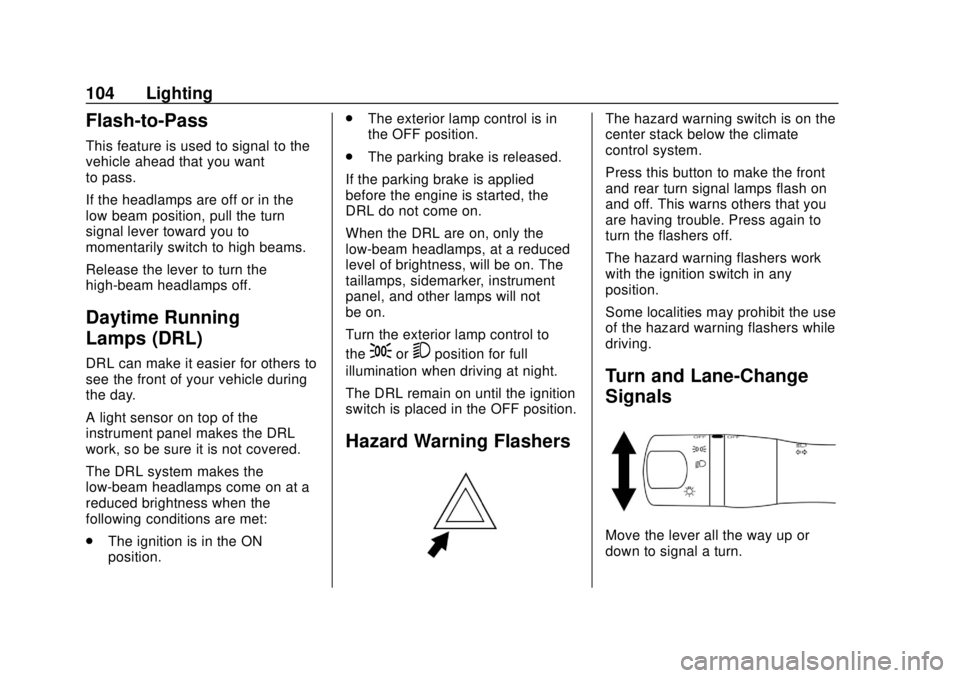
Chevrolet City Express Owner Manual (GMNA-Localizing-U.S./Canada-
11683523) - 2018 - CRC - 7/10/17
104 Lighting
Flash-to-Pass
This feature is used to signal to the
vehicle ahead that you want
to pass.
If the headlamps are off or in the
low‐beam position, pull the turn
signal lever toward you to
momentarily switch to high beams.
Release the lever to turn the
high-beam headlamps off.
Daytime Running
Lamps (DRL)
DRL can make it easier for others to
see the front of your vehicle during
the day.
A light sensor on top of the
instrument panel makes the DRL
work, so be sure it is not covered.
The DRL system makes the
low-beam headlamps come on at a
reduced brightness when the
following conditions are met:
.The ignition is in the ON
position. .
The exterior lamp control is in
the OFF position.
. The parking brake is released.
If the parking brake is applied
before the engine is started, the
DRL do not come on.
When the DRL are on, only the
low-beam headlamps, at a reduced
level of brightness, will be on. The
taillamps, sidemarker, instrument
panel, and other lamps will not
be on.
Turn the exterior lamp control to
the;or5position for full
illumination when driving at night.
The DRL remain on until the ignition
switch is placed in the OFF position.
Hazard Warning Flashers
The hazard warning switch is on the
center stack below the climate
control system.
Press this button to make the front
and rear turn signal lamps flash on
and off. This warns others that you
are having trouble. Press again to
turn the flashers off.
The hazard warning flashers work
with the ignition switch in any
position.
Some localities may prohibit the use
of the hazard warning flashers while
driving.
Turn and Lane-Change
Signals
Move the lever all the way up or
down to signal a turn.
Page 159 of 287
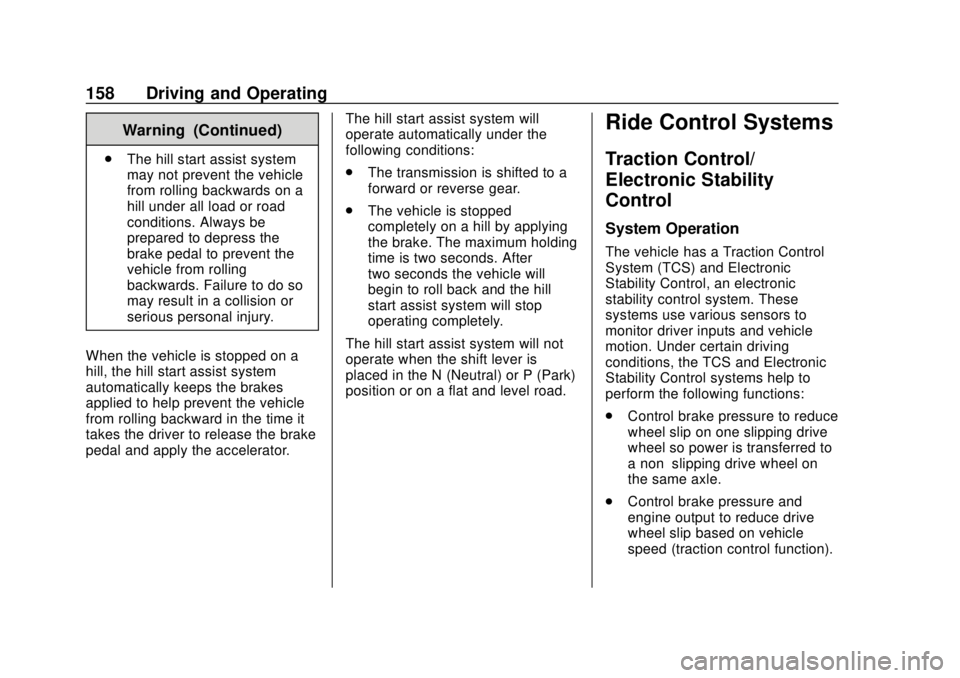
Chevrolet City Express Owner Manual (GMNA-Localizing-U.S./Canada-
11683523) - 2018 - CRC - 7/10/17
158 Driving and Operating
Warning (Continued)
.The hill start assist system
may not prevent the vehicle
from rolling backwards on a
hill under all load or road
conditions. Always be
prepared to depress the
brake pedal to prevent the
vehicle from rolling
backwards. Failure to do so
may result in a collision or
serious personal injury.
When the vehicle is stopped on a
hill, the hill start assist system
automatically keeps the brakes
applied to help prevent the vehicle
from rolling backward in the time it
takes the driver to release the brake
pedal and apply the accelerator. The hill start assist system will
operate automatically under the
following conditions:
.
The transmission is shifted to a
forward or reverse gear.
. The vehicle is stopped
completely on a hill by applying
the brake. The maximum holding
time is two seconds. After
two seconds the vehicle will
begin to roll back and the hill
start assist system will stop
operating completely.
The hill start assist system will not
operate when the shift lever is
placed in the N (Neutral) or P (Park)
position or on a flat and level road.
Ride Control Systems
Traction Control/
Electronic Stability
Control
System Operation
The vehicle has a Traction Control
System (TCS) and Electronic
Stability Control, an electronic
stability control system. These
systems use various sensors to
monitor driver inputs and vehicle
motion. Under certain driving
conditions, the TCS and Electronic
Stability Control systems help to
perform the following functions:
. Control brake pressure to reduce
wheel slip on one slipping drive
wheel so power is transferred to
a non–slipping drive wheel on
the same axle.
. Control brake pressure and
engine output to reduce drive
wheel slip based on vehicle
speed (traction control function).